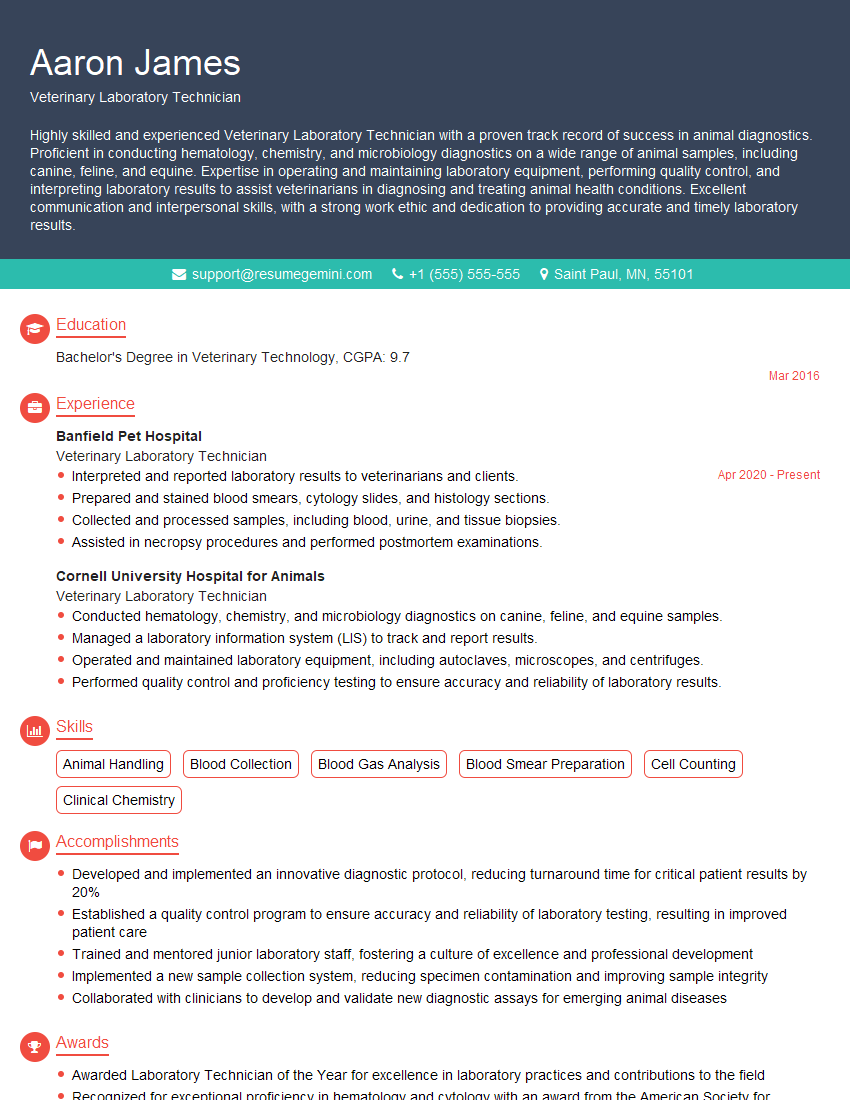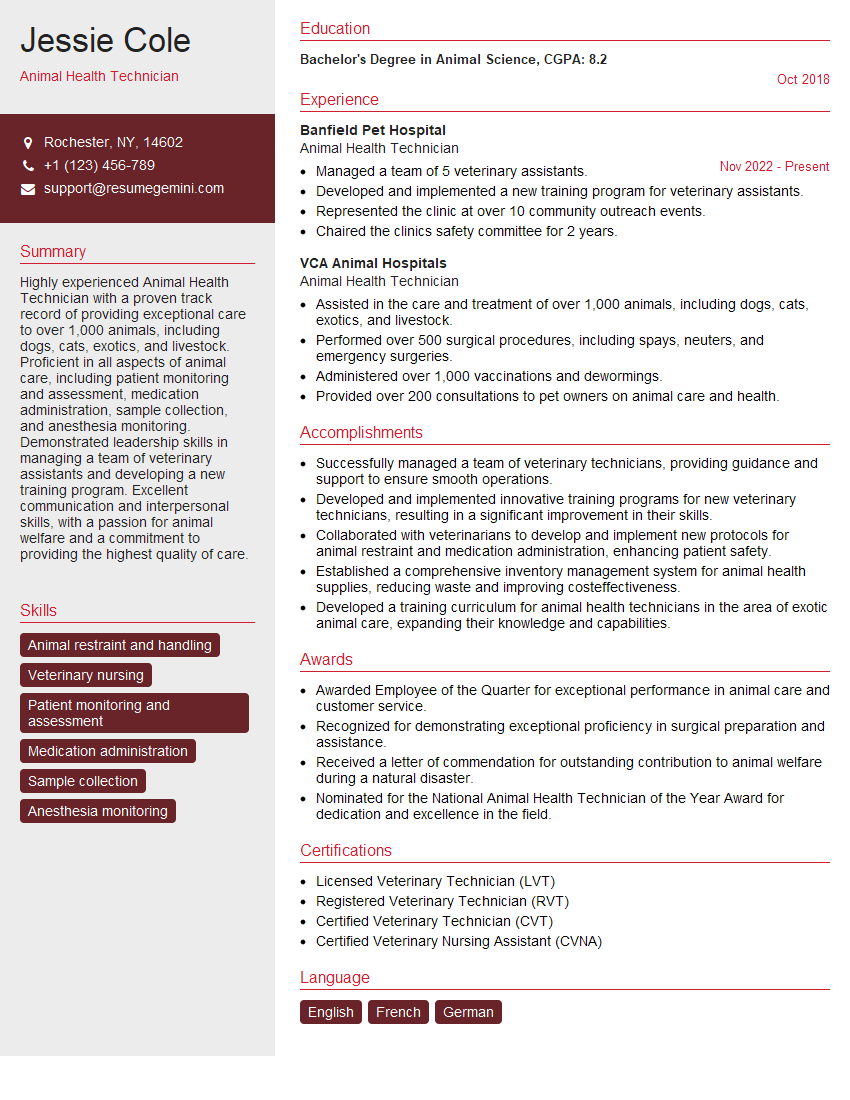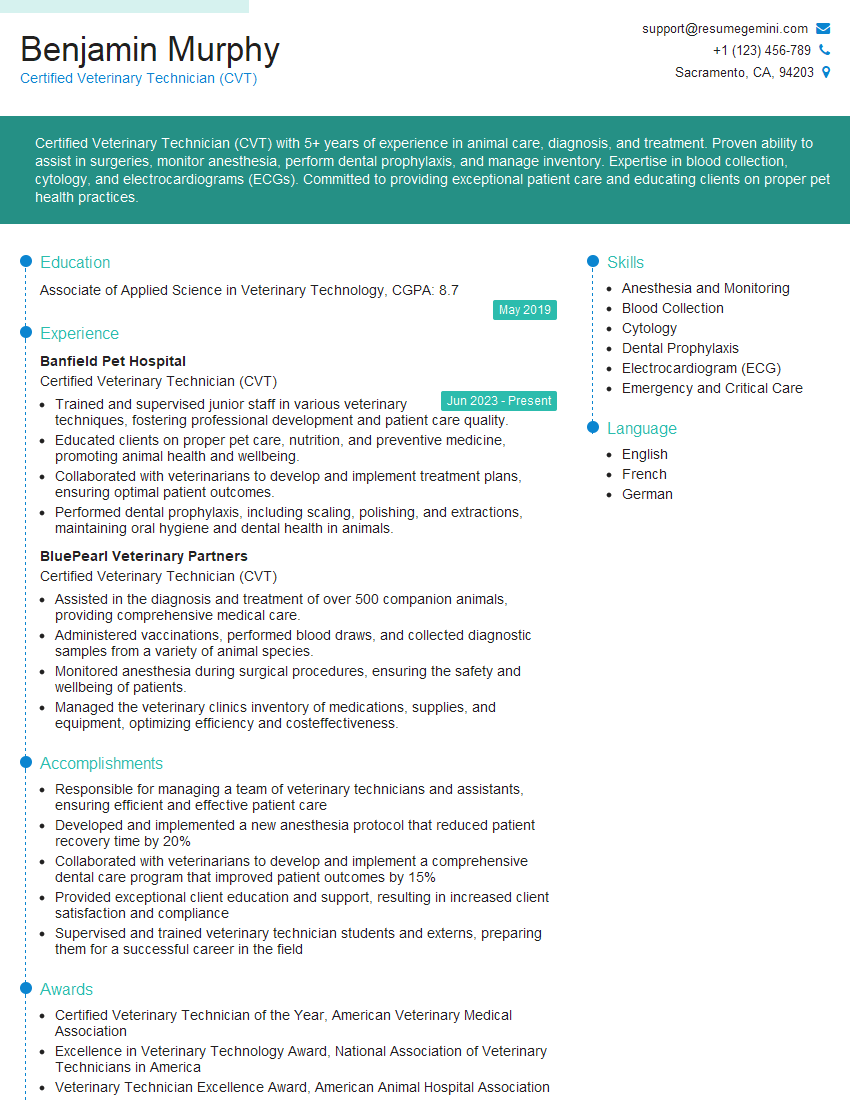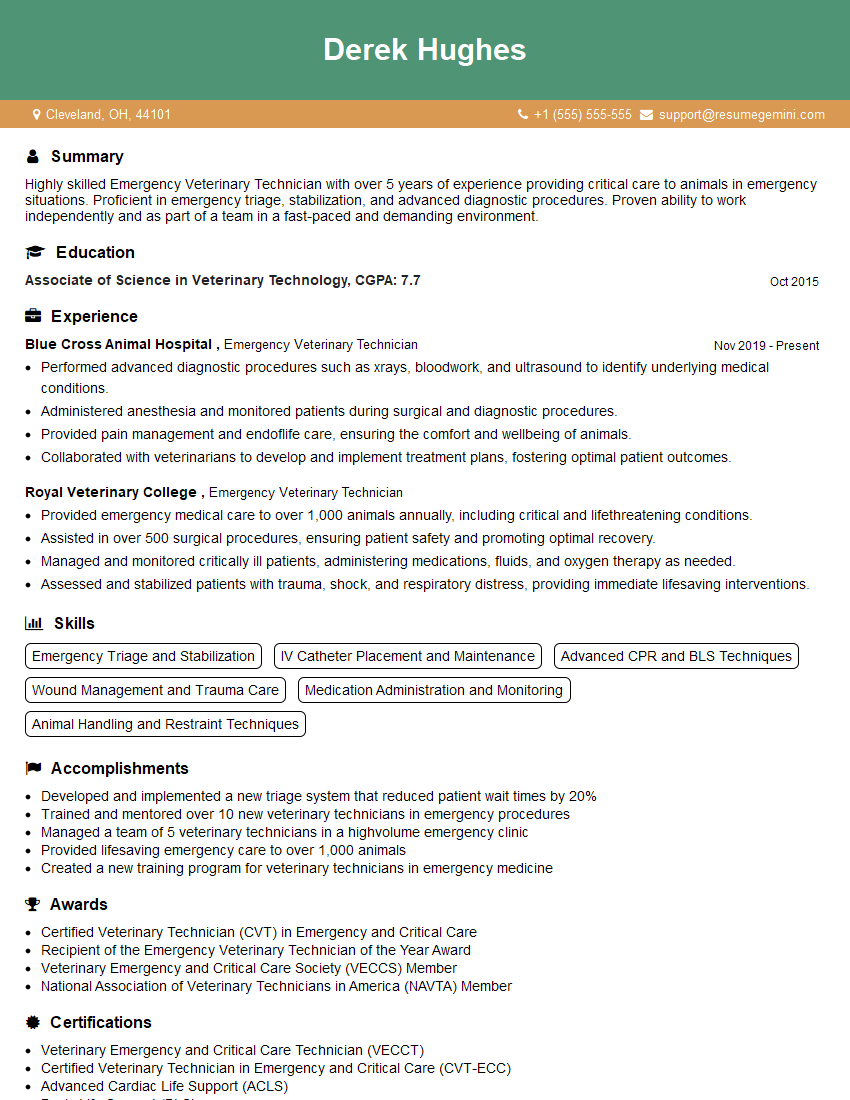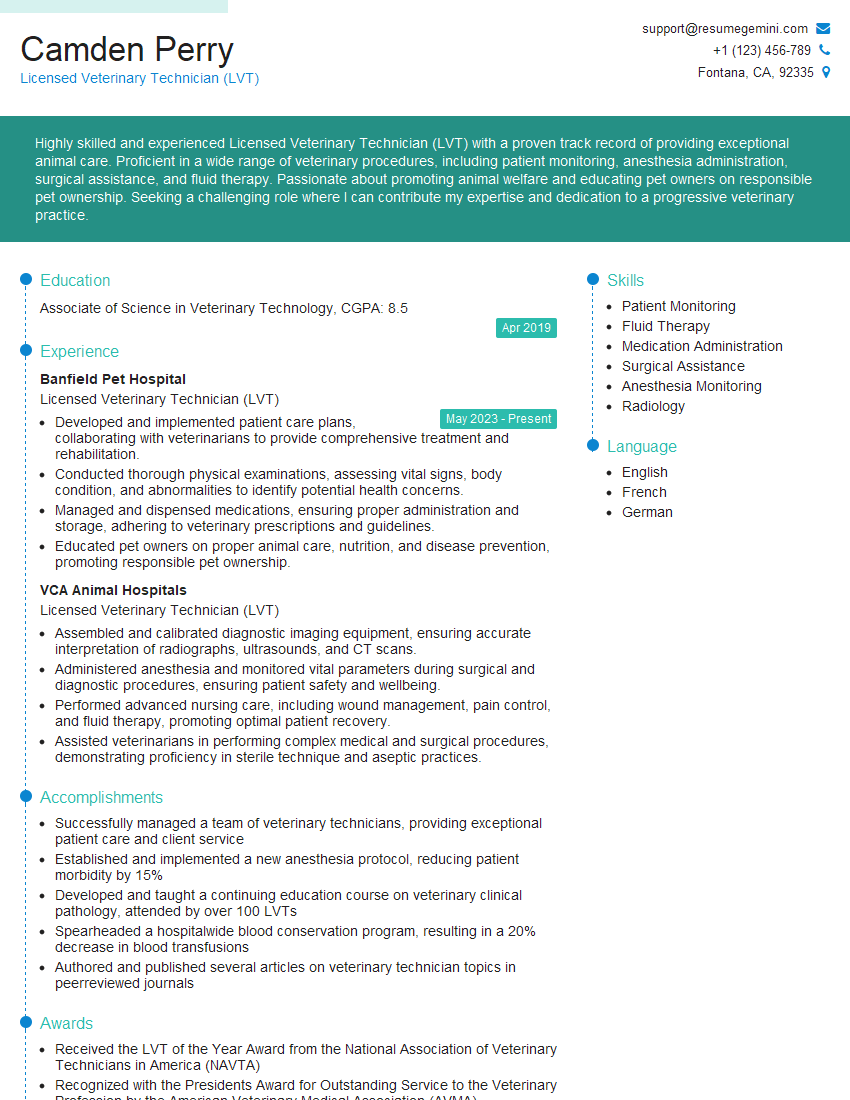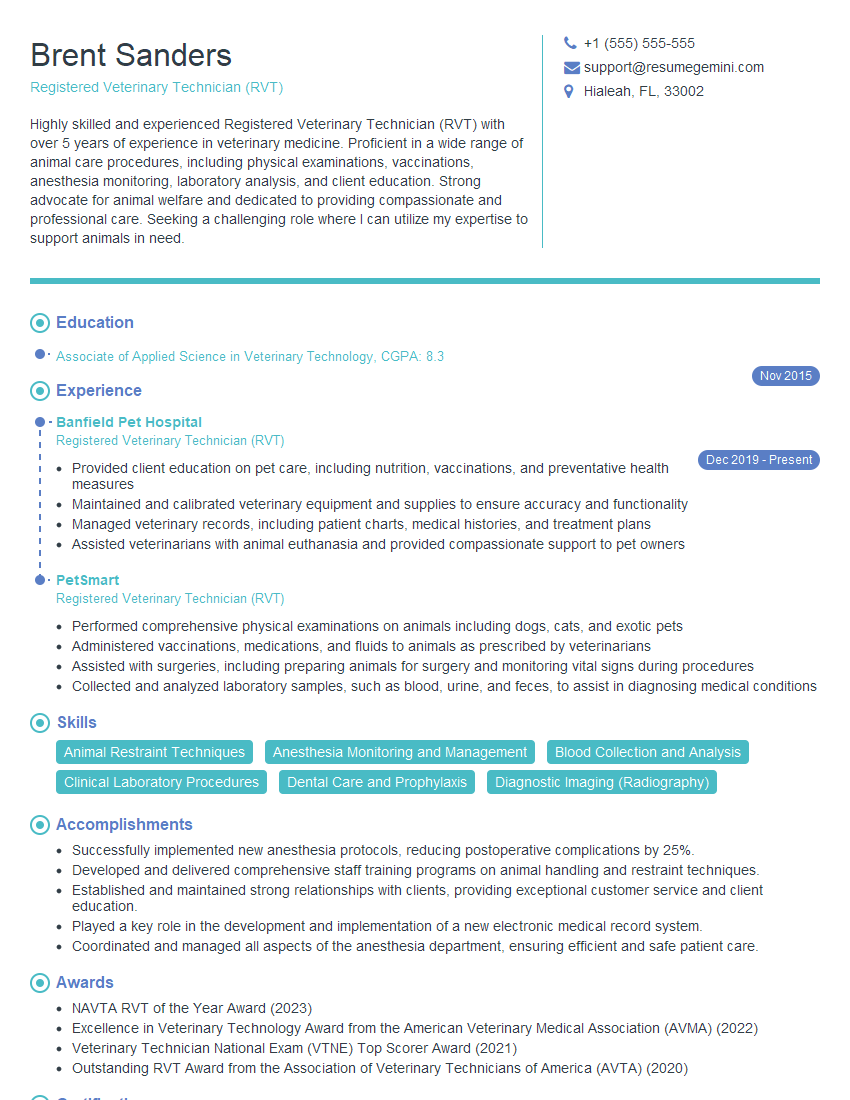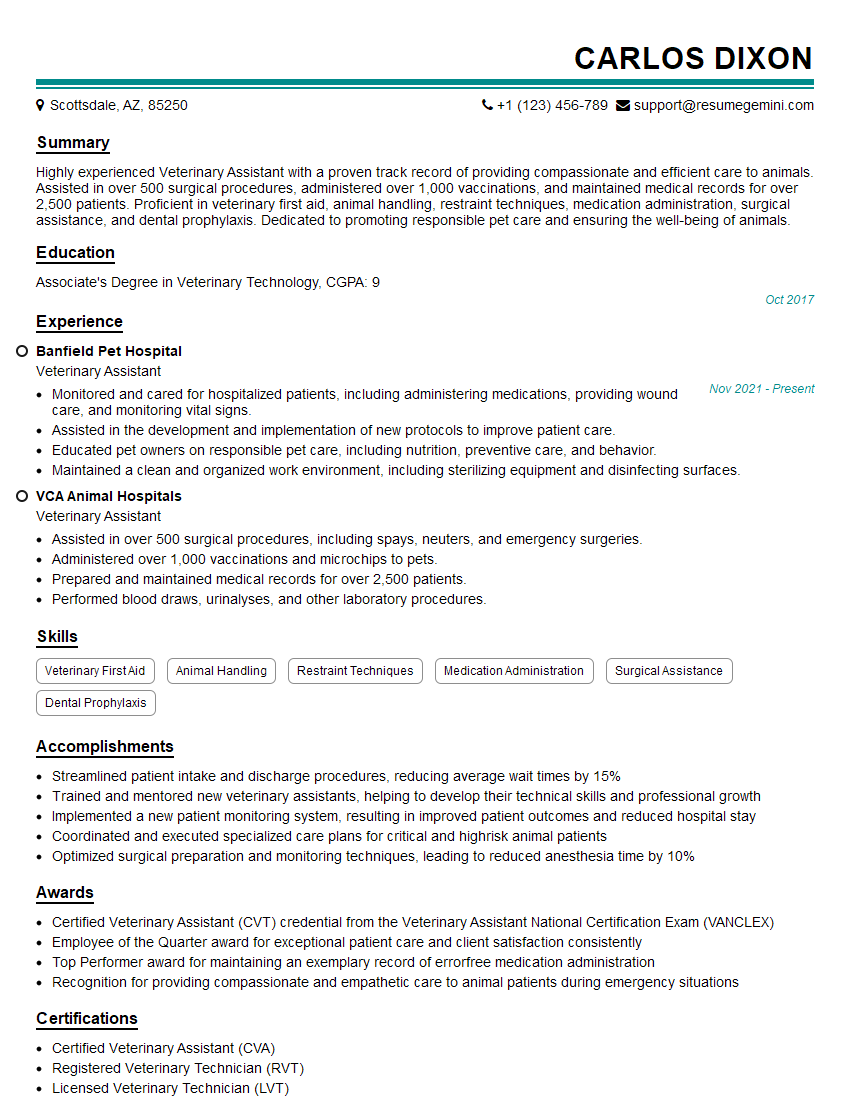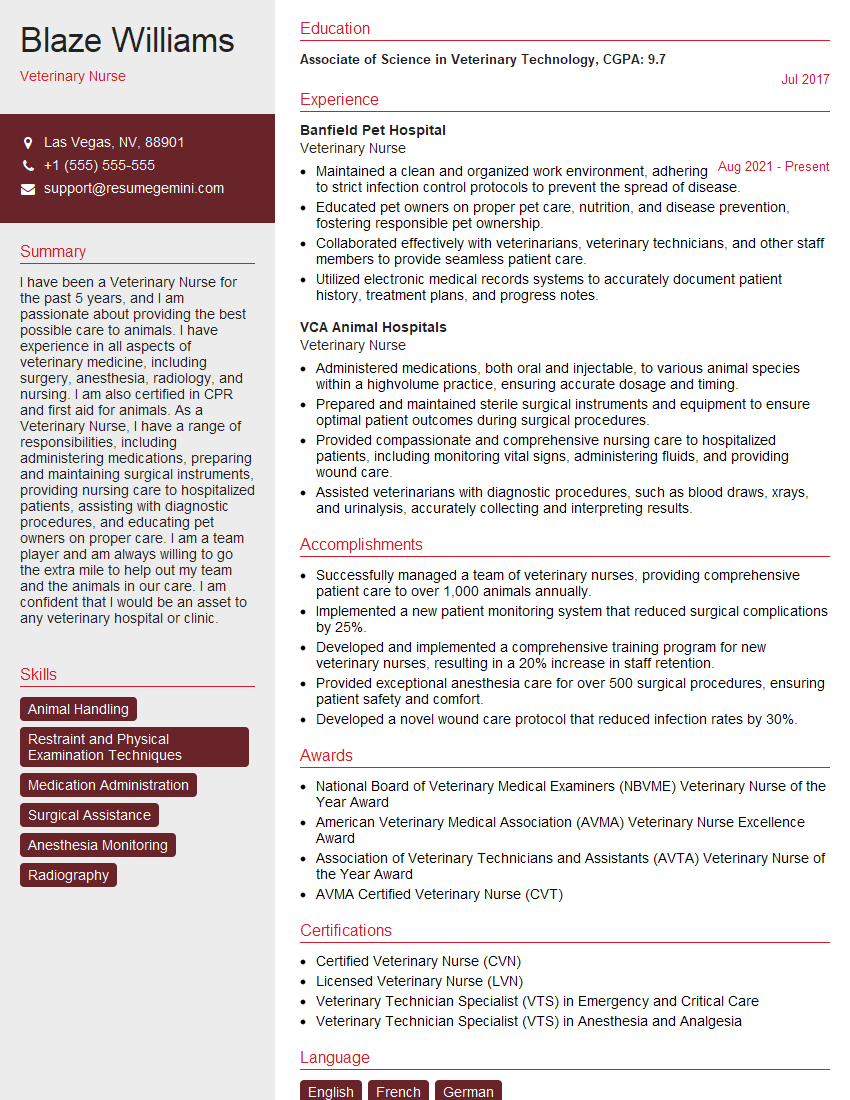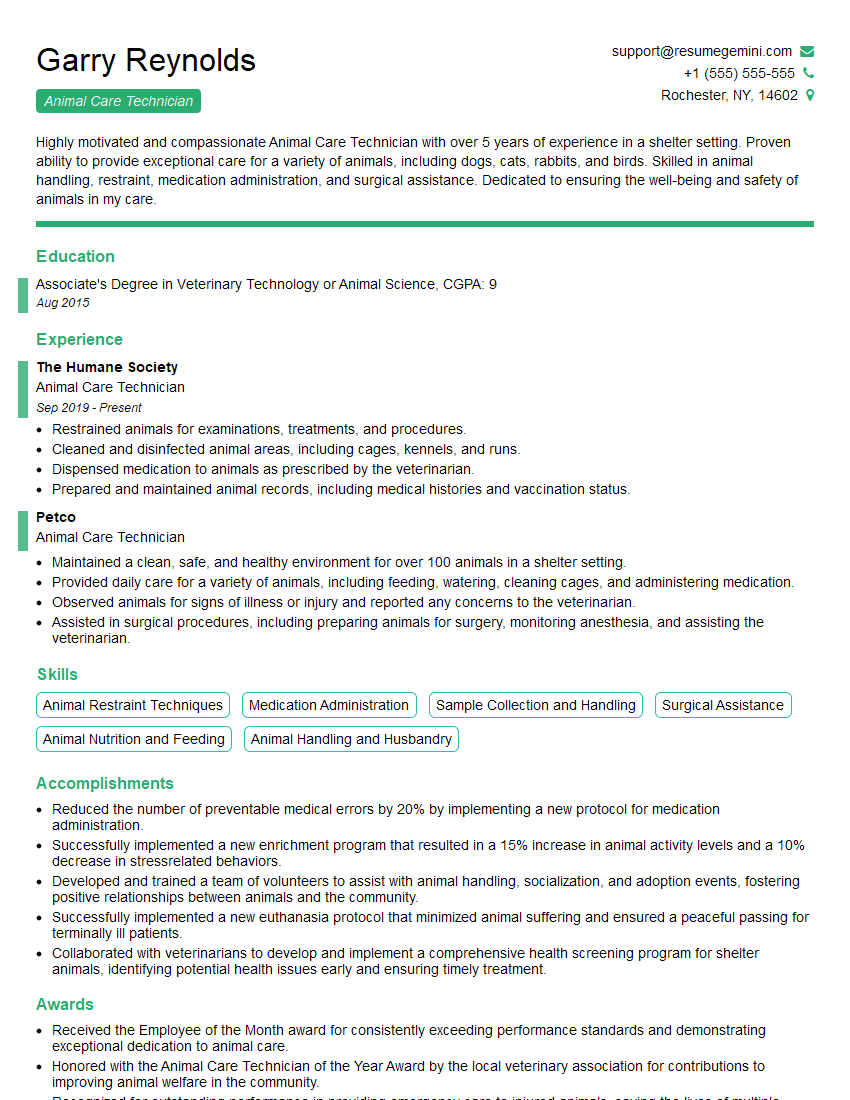Every successful interview starts with knowing what to expect. In this blog, we’ll take you through the top Basic Veterinary Skills interview questions, breaking them down with expert tips to help you deliver impactful answers. Step into your next interview fully prepared and ready to succeed.
Questions Asked in Basic Veterinary Skills Interview
Q 1. Describe the proper procedure for administering subcutaneous injections.
Administering subcutaneous (SQ) injections requires precision and aseptic technique to prevent infection and ensure proper drug absorption. Think of it like gently placing the medication just under the skin, like a tiny, shallow puddle.
- Gather Supplies: Sterile gloves, appropriate syringe and needle (size depends on the medication and animal size), antiseptic solution (e.g., chlorhexidine), medication, and gauze pads.
- Prepare the Injection Site: Select a loose skin area, typically on the side of the neck or behind the shoulders in dogs and cats. Clip the hair if necessary and clean the area thoroughly with antiseptic solution, working in a circular motion from the center outwards.
- Prepare the Syringe: Draw up the correct dosage of medication into the syringe. Double-check the dosage before injecting.
- Pinch the Skin: Gently pinch a fold of skin to create a tent. This helps ensure the needle is inserted into subcutaneous tissue and not muscle.
- Insert the Needle: Insert the needle at a 45-degree angle for smaller animals and a 90-degree angle for larger animals. Avoid going too deep; you should feel minimal resistance.
- Inject Slowly: Slowly inject the medication. If you encounter resistance, slightly reposition the needle.
- Withdraw the Needle: Withdraw the needle at the same angle it was inserted. Gently massage the injection site to promote absorption, but avoid vigorous rubbing.
- Dispose of Supplies: Properly dispose of used needles and syringes in a sharps container.
Example: When administering a subcutaneous fluid to a dehydrated kitten, I would choose a very small needle and a loose area on the neck, ensuring to pinch the skin to create a tent for the injection. Slow injection is crucial to prevent discomfort and ensure proper absorption.
Q 2. Explain the signs of dehydration in a canine patient.
Dehydration in dogs manifests in several ways, affecting their overall well-being. Think of it like a wilting plant – lack of water causes visible changes.
- Sunken Eyes: The eyes appear recessed in their sockets.
- Dry Mucous Membranes (Gums): The gums appear dry and sticky instead of moist and pink. You can gently pull back the lip to assess this.
- Loss of Skin Elasticity (Skin Tent): When you gently pinch the skin on the neck, it will slowly return to its original position in a well-hydrated dog. In a dehydrated dog, the skin will stay tented for an extended period.
- Lethargy and Weakness: Dehydrated dogs often appear less energetic and weak.
- Decreased Urine Output: Reduced urination is a common sign of dehydration.
- Potential for Shock (Severe Dehydration): In severe cases, dehydration can lead to shock, characterized by rapid weak pulse, pale gums, and collapse.
Example: A dog brought in after several days without access to water might present with sunken eyes, dry gums, and skin tenting. This would prompt immediate intravenous fluid therapy.
Q 3. How would you safely restrain a cat for a physical examination?
Safely restraining a cat for a physical exam requires a gentle yet firm approach, prioritizing the cat’s safety and comfort. Think of it like a delicate dance, avoiding sudden movements.
- Towel Restraint: A towel can effectively restrain a cat while minimizing stress. Wrap the cat gently in the towel, leaving its head exposed for examination but securing its legs and body.
- Minimal Handling: Handle the cat calmly and confidently, speaking in a soft, soothing voice. Avoid sudden movements that might startle the animal.
- Use of a Carrier: If possible, perform the examination inside the cat’s familiar carrier to reduce stress.
- Support the Body: Ensure you’re providing adequate support for the cat’s body weight to avoid causing discomfort or injury.
- Collaborate With an Assistant: If possible, have an assistant help during the examination. One person can gently restrain the cat while the other performs the examination.
Example: When examining a feisty cat, I’d use a towel to gently restrict movement while an assistant supported the cat’s body. This ensures both our safety and the cat’s comfort.
Q 4. What are the common signs of feline respiratory distress?
Feline respiratory distress is a serious condition that requires immediate attention. Recognizing the signs early is crucial for effective intervention. Think of it as the cat’s body struggling to get enough oxygen.
- Open-Mouth Breathing: Cats usually breathe through their noses. Open-mouth breathing indicates difficulty breathing.
- Rapid Breathing (Tachypnea): An increased respiratory rate, often accompanied by visible effort.
- Increased Respiratory Effort: Using the chest and abdominal muscles more than normal to breathe.
- Blue or Gray Gums (Cyanosis): Indicates low blood oxygen levels.
- Coughing: A persistent or harsh cough can signal underlying respiratory issues.
- Wheezing or Rattling Sounds: Abnormal sounds during breathing.
Example: A cat presenting with rapid, labored breathing, open mouth breathing, and bluish gums requires immediate assessment and emergency oxygen therapy.
Q 5. Detail the steps involved in taking a dog’s vital signs (temperature, pulse, respiration).
Taking a dog’s vital signs – temperature, pulse, and respiration – is fundamental to assessing its overall health. Regular monitoring is critical in managing illness and assessing response to treatment. Think of this as your baseline data, providing a snapshot of the dog’s health status.
- Temperature: Use a rectal thermometer lubricated with petroleum jelly. Insert gently about an inch. Normal canine temperature is approximately 101-102.5°F (38.3-39.2°C).
- Pulse: Palpate the femoral artery (inside the thigh) or the digital artery (on the inside of the rear leg). Count the number of beats per minute (BPM). Normal canine pulse ranges from 60-120 BPM. Consider the rhythm and strength of the pulse.
- Respiration: Observe the rise and fall of the chest or abdomen. Count the number of breaths per minute (BPM). Normal canine respiration rates range from 10-30 BPM. Note if the breathing is labored or shallow.
Example: While examining a dog with suspected pneumonia, I carefully took its temperature (103°F), pulse (110 BPM, slightly rapid), and respiration rate (35 BPM, rapid and labored). These findings pointed towards a more serious condition than initially expected.
Q 6. How do you recognize and respond to an animal experiencing a seizure?
Recognizing and responding appropriately to a seizure in an animal is crucial. A seizure is a neurological event that can cause a range of symptoms, and rapid action can help minimize harm and provide comfort. Think of it as a temporary neurological storm.
- Recognize the Signs: Seizures can manifest as involuntary muscle contractions, loss of consciousness, salivation, urination/defecation, and paddling movements of the limbs.
- Ensure Safety: Move the animal to a safe location to prevent injury during the seizure. Remove any surrounding objects that could cause harm.
- Do Not Restrain: Never try to restrain the animal during a seizure. This can be dangerous for both the animal and handler.
- Time the Seizure: Note the duration of the seizure. Seizures lasting longer than 5 minutes are considered emergencies requiring immediate veterinary attention.
- Post-Seizure Care: After the seizure, keep the animal quiet and warm in a safe space. It will likely be disoriented and lethargic for some time.
- Seek Veterinary Care: Contact your veterinarian or an emergency animal hospital immediately after the seizure. This is crucial for determining the cause and initiating appropriate treatment.
Example: During a routine appointment, a dog suddenly started seizing. I immediately moved any furniture out of the way, ensured a soft landing area, timed the seizure, and contacted the owner to arrange for immediate transport to an emergency hospital.
Q 7. Explain the importance of proper wound cleaning and bandaging techniques.
Proper wound cleaning and bandaging are essential for preventing infection and promoting healing. Think of it like creating an ideal environment for the wound to recover. This process involves careful preparation, meticulous cleaning, and the appropriate application of bandages.
- Assessment: Thoroughly assess the wound’s depth, size, and presence of foreign bodies before commencing treatment.
- Cleaning: Gently flush the wound with sterile saline solution to remove debris and contaminants. Avoid harsh scrubbing, which can further damage the tissues.
- Debridement (if necessary): Remove any dead tissue or foreign bodies that may be impeding healing. This may require professional veterinary care.
- Antiseptic Application: Apply a suitable antiseptic, such as chlorhexidine, to reduce the bacterial load. Follow product guidelines for application.
- Bandaging: Apply a sterile bandage to protect the wound from further contamination and provide support for healing. The bandage should be clean, secure, but not constricting blood flow. Regular checks for swelling, pain or discoloration are critical.
- Monitoring: Monitor the wound regularly for signs of infection (increased pain, swelling, redness, discharge). Any change should prompt immediate veterinary attention.
Example: A dog presented with a laceration on its leg. After carefully cleaning and flushing the wound with sterile saline, I applied a thin layer of antiseptic and then a sterile non-adhesive dressing, secured with a bandage that allowed for circulation and easy wound observation.
Q 8. Describe the process of collecting a urine sample from a dog.
Collecting a urine sample from a dog requires a gentle and efficient approach to minimize stress for the animal. The method chosen often depends on the dog’s temperament and the urgency of the situation.
- Free Catch Method: This is the simplest method, suitable for cooperative dogs. You’ll need a clean, dry container. The dog is allowed to urinate naturally, and you collect the urine stream mid-stream to avoid contamination from the external genitalia. This method is best for obtaining a large volume sample. However, it is unreliable and may not be possible for all animals.
- Manual Expression: This method involves gently pressing on the bladder to express urine. It’s only used when absolutely necessary and should be performed by trained personnel, as improper technique can cause injury. It is not ideal for routine testing.
- Catheterization: This involves inserting a sterile catheter into the urethra to collect urine. This method is sterile and provides a clean sample, but requires specialized training and aseptic technique to prevent infection. It is typically reserved for cases where free catch or manual expression is not feasible.
- Cystocentesis: This involves using a needle to directly aspirate urine from the bladder under ultrasound guidance. It’s a sterile technique providing a very clean sample, but requires advanced skills and carries a small risk of bladder perforation or infection. This is the preferred method for obtaining sterile urine samples for culture and sensitivity testing.
Regardless of the method used, it’s crucial to label the sample clearly with the dog’s name, date, and time of collection to ensure accurate results.
Q 9. What are the different methods for administering oral medications to animals?
Administering oral medications to animals requires careful consideration of the animal’s temperament and the medication’s properties. Several methods exist, each with advantages and disadvantages:
- Directly into the mouth: For smaller animals, a pill can be placed directly at the back of the tongue using your fingers or a pill-gun to encourage swallowing. This is often best suited for cooperative, smaller animals.
- Hiding medication in food: Mixing the medication with a highly palatable food that the animal readily consumes can make administration easy. However, ensure the animal consumes the entire amount of food to guarantee the full dose is given.
- Using flavored syringes or pill pockets: These options make medication easier to administer and more palatable for animals. The pill is hidden inside a tasty pouch or dispensed using a syringe, making it a more positive experience.
- Using a pilling device (pill gun): This instrument is designed to accurately place a pill at the back of an animal’s throat, which can be helpful when dealing with larger or less cooperative animals. Care should be taken to avoid damaging the teeth or causing injury.
It’s important to always follow the veterinarian’s instructions regarding the dosage and frequency of administration. Observe the animal for signs of adverse reactions after administering the medication.
Q 10. How would you handle a patient exhibiting aggressive behavior?
Handling an aggressive patient requires a calm, methodical approach prioritizing the safety of both the animal and the personnel. Never approach an aggressive animal without proper preparation and safety equipment.
- Assessment: Identify the trigger for the aggression. Is it fear, pain, territoriality, or something else? Understanding the cause can guide your approach.
- Safety Precautions: Always wear appropriate personal protective equipment (PPE), including gloves, thick clothing, and possibly a muzzle and/or bite-resistant sleeves. Ensure adequate space between yourself and the animal. Have a second person present for assistance if possible.
- Calm Demeanor: Approach slowly and avoid sudden movements. Speak in a calm, soothing voice. Avoid direct eye contact, which can be perceived as threatening.
- Restraint Techniques: Use appropriate restraint techniques, considering the size and strength of the animal. This might involve a towel, a capture pole, or other specialized equipment. Never try to force an animal into submission.
- Seeking Assistance: If you feel unsafe or unable to handle the situation, seek assistance from a colleague or experienced handler immediately.
- Veterinary Attention: The cause of the aggression should be thoroughly investigated by a veterinarian who can make recommendations for managing the behavior, potentially including medications or behavioral modification.
Remember, safety is paramount. If the situation becomes unsafe, prioritize your safety and retreat to a secure location. The animal’s health and well-being are important, but not at the expense of human safety.
Q 11. Explain the proper use of an ophthalmoscope and otoscope.
The ophthalmoscope and otoscope are essential tools for examining the eyes and ears, respectively. Proper use requires careful technique and understanding of the anatomy.
- Ophthalmoscope: This instrument allows visualization of the internal structures of the eye. The user shines a light into the pupil, allowing examination of the retina, optic nerve, and other structures. Proper technique involves using the appropriate lens to obtain a clear image, adjusting the light intensity, and maintaining a comfortable position for the animal.
- Otoscope: This device provides visualization of the external ear canal and tympanic membrane (eardrum). The user gently inserts the speculum into the ear canal, using the light source to examine the structures within. Proper technique involves gentle handling to avoid causing pain or injury, and selecting the appropriate size speculum for the animal’s ear canal.
Both instruments require practice and skill to utilize effectively. Proper training is essential to learn how to interpret the findings and communicate them to the veterinarian.
Example: When using an ophthalmoscope, you might see signs of retinal detachment, cataracts, or glaucoma. With an otoscope, you might find ear infections, foreign bodies, or tumors.
Q 12. What are the common signs of shock in animals?
Shock is a life-threatening condition characterized by inadequate blood flow to the tissues and organs. Recognizing the signs is crucial for prompt intervention.
- Weak, rapid pulse:** The heart is beating faster and weaker than usual.
- Pale gums:** Pale, white, or bluish gums indicate poor blood circulation.
- Rapid, shallow breathing:** The animal is breathing quickly and superficially.
- Low body temperature:** The animal may feel cold to the touch.
- Weakness or collapse:** The animal may be unable to stand or walk.
- Lethargy or dullness:** The animal is unresponsive and shows decreased mental alertness.
- Prolonged capillary refill time:** Gums will stay white longer after applying pressure and releasing.
These signs can vary in severity depending on the cause and duration of shock. Immediate veterinary care is essential if these symptoms are observed.
Q 13. Describe your experience with assisting with surgical procedures.
I have assisted in numerous surgical procedures, gaining valuable experience in surgical preparation, sterile technique, and postoperative care. My duties have included:
- Preparing the surgical site, ensuring proper sterilization and draping.
- Assisting the surgeon with instrumentation and handling tissues.
- Maintaining the sterile field and monitoring vital signs.
- Preparing and administering medications as directed.
- Assisting with postoperative care, including monitoring the animal’s recovery and administering fluids or medications.
For example, I assisted in a splenectomy on a canine patient. I learned the importance of meticulous attention to detail during the procedure. This experience deepened my understanding of surgical protocols and enhanced my practical surgical skills. I’m comfortable working in a fast-paced surgical environment and committed to ensuring the safety and welfare of the patient.
Q 14. How familiar are you with different types of animal restraint equipment?
I am familiar with a range of animal restraint equipment, selected based on the species, size, temperament, and the specific procedure. This includes:
- Muzzles:** Used to prevent biting, especially in aggressive or anxious animals.
- Catch poles:** Long poles with loops or nets used to safely restrain animals from a distance.
- Restraint bags:** Fabric bags to gently contain small animals.
- Lead ropes and harnesses:** Used to secure and guide larger animals.
- Gauze and towels:** Simple but effective tools for immobilizing limbs or portions of the body.
- Specialized slings and cradles:** Used to safely support and move injured or debilitated animals.
The choice of restraint depends on the situation and the animal’s behavior. Improper restraint can lead to injury, so proper training is crucial. I always prioritize the animal’s safety and comfort during restraint.
Q 15. What is your experience with venipuncture in various animal species?
Venipuncture, the process of drawing blood from a vein, is a fundamental skill in veterinary medicine. My experience encompasses a wide range of animal species, from small animals like cats and dogs to larger animals such as horses and cattle. The technique varies depending on the species and the size of the animal. For instance, in a small dog, I’d likely use a 25-gauge needle in a cephalic vein in the front leg, while in a horse, I might use a larger gauge needle in the jugular vein in the neck. Safety is paramount, and I always ensure proper restraint, appropriate needle size selection, and diligent attention to asepsis to minimize the risk of complications like hematoma formation. I’ve successfully performed hundreds of venipunctures, developing a keen eye for identifying suitable veins and mastering the technique for a swift and painless procedure for the animal.
Specific examples include navigating the challenging venous structures in obese cats, successfully drawing blood samples from fractious horses using appropriate sedation and restraint techniques, and adapting my approach based on the individual animal’s temperament and health status. I’m proficient in various venipuncture sites, adapting based on the animal’s breed, size, and condition.
Career Expert Tips:
- Ace those interviews! Prepare effectively by reviewing the Top 50 Most Common Interview Questions on ResumeGemini.
- Navigate your job search with confidence! Explore a wide range of Career Tips on ResumeGemini. Learn about common challenges and recommendations to overcome them.
- Craft the perfect resume! Master the Art of Resume Writing with ResumeGemini’s guide. Showcase your unique qualifications and achievements effectively.
- Don’t miss out on holiday savings! Build your dream resume with ResumeGemini’s ATS optimized templates.
Q 16. Explain the importance of maintaining a clean and sanitary veterinary environment.
Maintaining a clean and sanitary environment is crucial in veterinary medicine for several reasons: preventing the spread of infectious diseases, protecting both animal and human health, and ensuring patient well-being. A contaminated environment can lead to cross-contamination between patients, resulting in outbreaks of diseases like kennel cough or ringworm. Proper sanitation also reduces the risk of nosocomial infections, preventing the spread of bacteria to patients undergoing surgical procedures or those with compromised immune systems. Think of it like this: just as we would thoroughly clean a hospital operating room, we must maintain a sterile environment in a veterinary clinic to safeguard patient health.
My approach involves adherence to strict protocols such as regular disinfection of examination rooms, surgical suites, and cages; proper sterilization of instruments using autoclaves; practicing meticulous hand hygiene; and using appropriate personal protective equipment (PPE) like gloves, gowns, and masks. I always follow the appropriate protocols for waste disposal, particularly hazardous waste like needles and sharps, and regularly monitor the environment for potential sources of contamination.
Q 17. How do you recognize and respond to signs of anaphylaxis in an animal?
Anaphylaxis is a severe, life-threatening allergic reaction. In animals, it can manifest rapidly with symptoms like difficulty breathing (dyspnea), hives (urticaria), swelling of the face and muzzle (angioedema), vomiting, diarrhea, and collapse. Recognizing these signs is crucial for prompt intervention as anaphylaxis can be fatal if left untreated. I’ve encountered cases where animals experienced anaphylactic shock after receiving vaccinations or certain medications.
My immediate response involves administering epinephrine (adrenaline) subcutaneously or intramuscularly, the first-line treatment for anaphylaxis. This helps to counteract the effects of histamine, the chemical mediator responsible for the allergic reaction. Simultaneously, I’d provide supportive care, such as oxygen therapy and intravenous fluids to maintain blood pressure. Monitoring vital signs like heart rate, respiratory rate, and oxygen saturation is critical. Depending on the severity of the reaction, further interventions like antihistamines and corticosteroids might be necessary. Immediate transport to an emergency veterinary facility might be required if the condition doesn’t stabilize.
Q 18. Describe your experience with dental prophylaxis procedures.
Dental prophylaxis, or professional teeth cleaning, is a vital part of preventative care in veterinary medicine. My experience includes performing numerous dental prophylaxis procedures on various animal species. This involves a thorough scaling of the teeth to remove plaque and tartar buildup, followed by polishing to smooth the tooth surfaces and prevent further accumulation. I am also proficient in extracting teeth when necessary.
The process typically begins with a thorough oral examination, including assessment of periodontal health. This involves assessing the gums, checking for signs of periodontal disease, and evaluating the teeth for fractures or other abnormalities. Following the cleaning and polishing, we apply fluoride treatments to strengthen tooth enamel. Radiographs may be taken to evaluate for hidden issues beneath the gum line. Patient comfort is a priority. Sedation or anesthesia is often used, especially for anxious or fractious animals, to ensure a safe and effective procedure. Post-procedure care instructions are provided to the owner to maintain good oral hygiene at home.
Q 19. How would you handle a patient exhibiting signs of pain?
Recognizing and addressing pain in animals is a crucial aspect of providing compassionate and effective veterinary care. Signs of pain can be subtle or overt and vary depending on the species, the severity of the injury or illness, and the animal’s personality. These can include changes in posture, such as hunching or limping; vocalizations such as whining, whimpering, or crying; changes in behavior, such as decreased appetite, lethargy, or aggression; and physiological signs like increased heart rate, respiratory rate, and body temperature.
My approach starts with a thorough assessment of the patient to identify the source of pain. This involves a detailed physical examination, taking into account the animal’s history and any reported changes in behaviour. Depending on the suspected cause, diagnostic tests such as radiographs or blood work may be necessary. Pain management strategies vary based on the cause and severity of pain. They include analgesics (pain relievers), such as NSAIDs or opioids, and other supportive therapies such as rest, ice or heat application, and wound care. I always tailor my approach to the individual needs of the patient and communicate openly with the owner regarding the treatment plan and prognosis.
Q 20. Explain the proper method for administering ear medication.
Administering ear medication correctly is vital for effective treatment and to prevent potential harm to the animal. The process starts with a thorough examination of the ear canal to assess the extent of any inflammation or infection. Gentle restraint is essential, particularly in anxious animals.
I typically clean the external ear canal with a suitable ear cleaning solution to remove any debris or wax before administering medication. The medication is then gently instilled into the ear canal by directing the tip of the applicator towards the ear canal. After instilling the medication, I gently massage the base of the ear to ensure the medication is distributed evenly throughout the canal. Instructing pet owners on the proper technique and importance of compliance is a crucial part of ensuring successful treatment. Failure to follow correct procedures can lead to ineffective treatment or even accidental injury to the eardrum.
Q 21. What is your experience with performing basic laboratory tests?
Proficiency in performing basic laboratory tests is fundamental to providing comprehensive veterinary care. My experience includes performing a wide range of tests, including complete blood counts (CBCs), blood chemistries, urinalyses, and fecal examinations. I am skilled in operating and interpreting results from automated hematology analyzers and chemistry analyzers.
For example, I’m adept at performing a CBC to evaluate the different blood cell components, identifying potential infections or anemia. Similarly, I can perform blood chemistry analysis to assess organ function and detect metabolic disorders. These basic tests form the foundation for diagnostic decision-making, guiding treatment plans and monitoring patient responses to therapy. Understanding the limitations of each test and knowing when to consult a specialized laboratory is equally important. Ensuring proper sample collection and handling is critical to guaranteeing the accuracy of the results.
Q 22. How would you safely handle and dispose of biohazardous waste?
Safe handling and disposal of biohazardous waste is paramount in veterinary practice to protect both human and animal health. It involves a multi-step process adhering strictly to local regulations and guidelines.
Segregation: Different types of biohazardous waste need separate containers. Sharps (needles, scalpels) go into puncture-resistant containers. Other contaminated materials (bandages, gloves, etc.) are placed in leak-proof bags clearly labeled with biohazard symbols. This prevents accidental exposure and cross-contamination.
Packaging: All containers must be securely sealed and labeled. The labels should clearly indicate the contents and the biohazard symbol. Double bagging is often employed for additional security.
Storage: Biohazardous waste should be stored in a designated, secure area away from public access, preferably in a cool, dry place, and until it can be picked up by a licensed medical waste disposal service.
Disposal: Never dispose of biohazardous waste in regular trash. A licensed medical waste disposal company is responsible for the proper incineration or autoclaving (high-pressure steam sterilization) of the waste, rendering it safe for the environment.
Personal Protective Equipment (PPE): Always wear appropriate PPE, including gloves, gowns, and eye protection, when handling biohazardous waste to prevent any accidental exposure. After handling waste, rigorous handwashing is essential.
For example, I once witnessed a colleague inadvertently puncture a glove while handling a needle. Fortunately, they immediately followed protocol, reported the incident, and underwent post-exposure prophylaxis. This highlighted the importance of meticulous attention to detail throughout the entire process.
Q 23. Describe your understanding of animal behavior and temperament.
Understanding animal behavior and temperament is fundamental to providing safe and effective veterinary care. It allows me to tailor my approach to each individual animal, minimizing stress and ensuring a positive experience.
Body Language: I pay close attention to subtle cues such as ear position, tail carriage, and posture. For instance, a dog with its tail tucked low and ears pinned back might be fearful or aggressive, requiring a more cautious approach.
Species-Specific Behaviors: I’m aware of the species-specific behaviors and communication styles. Cats, for instance, often communicate through scent marking and subtle changes in facial expression. Recognizing this helps me anticipate their reactions and prevent unnecessary stress.
Breed Characteristics: While individual personalities vary, certain breeds may have predispositions to particular behaviors. For example, certain breeds are known for their protective instincts or herding tendencies, and this information is essential in handling them safely.
Environmental Factors: The environment significantly impacts animal behavior. A loud, crowded waiting room can exacerbate anxiety. I strive to create a calm and comfortable environment to promote relaxation.
In a recent case, I handled a highly anxious cat by using a slow, gentle approach, speaking in soft tones, and providing a safe space. This helped build trust and made it possible to perform the necessary examination.
Q 24. How do you ensure proper patient identification?
Accurate patient identification is critical to prevent medical errors. Several methods ensure this:
Microchip Scanning: Microchips are a reliable way to identify animals. We scan all animals upon arrival to verify their identity.
Collar Tags: While not foolproof, collar tags provide a quick initial identification.
Detailed Records: Maintaining clear and complete medical records, including a photograph of the animal, breed, age, and any distinguishing features, is crucial.
Client Confirmation: Always confirm the animal’s identity with the owner.
Multiple Identifiers: Whenever possible, we use a combination of methods for redundant confirmation. For instance, we cross-reference the microchip information with the collar tag and client records.
Imagine the consequences if we mistakenly administered medication to the wrong animal – a serious error that could be easily prevented with thorough identification procedures.
Q 25. What is your experience with radiographic techniques?
I possess considerable experience with radiographic techniques, including positioning, exposure settings, and image interpretation. My experience encompasses various species, from small mammals like rabbits to larger animals like dogs and cats.
Positioning: Proper positioning is crucial to obtain clear, diagnostic images. I am proficient in various positioning techniques for different anatomical areas, ensuring minimal distortion and optimal visualization.
Exposure Settings: I understand the relationship between kVp (kilovoltage peak), mAs (milliampere-seconds), and image quality. Accurate settings are essential to achieve appropriate contrast and density, minimizing the radiation dose to the patient.
Image Interpretation: I can interpret radiographic images, identifying fractures, luxations, foreign bodies, and other abnormalities. I am adept at using imaging software to enhance image quality and measure distances.
Radiation Safety: I always prioritize radiation safety, following strict protocols to minimize exposure to both myself and the patient. This includes using lead aprons, gloves, and thyroid shields when necessary.
For example, I recently used radiography to diagnose a subtle fracture in a small dog’s leg that was initially missed during a physical examination. The radiograph provided crucial information for accurate diagnosis and treatment planning.
Q 26. Explain your understanding of animal anatomy and physiology.
A strong understanding of animal anatomy and physiology is the cornerstone of veterinary medicine. It allows for accurate diagnosis, appropriate treatment, and effective communication with colleagues. My knowledge encompasses:
Skeletal System: I have detailed knowledge of the bones, joints, and ligaments of various animal species. This is essential for diagnosing fractures, luxations, and other musculoskeletal problems.
Muscular System: I understand the functions and interactions of various muscle groups, enabling the diagnosis and treatment of muscular injuries and diseases.
Nervous System: My knowledge extends to the structure and function of the brain, spinal cord, and nerves. This is crucial for diagnosing neurological disorders.
Cardiovascular System: I understand the workings of the heart, blood vessels, and blood circulation. This knowledge is crucial for diagnosing cardiac conditions.
Respiratory System: I understand the processes involved in breathing, gas exchange, and respiratory diseases.
Digestive System: I possess in-depth knowledge of the digestive tract and its associated organs and functions, essential for diagnosing digestive disorders.
This extensive knowledge base allows me to accurately interpret clinical signs and devise suitable treatment plans tailored to the specific needs of each animal. For example, my understanding of canine anatomy allowed me to quickly pinpoint the source of a dog’s lameness.
Q 27. Describe your experience with electrocardiogram (ECG) monitoring.
I have experience with electrocardiogram (ECG) monitoring, involving both obtaining readings and interpreting the resulting waveforms. ECG monitoring is crucial for assessing the heart’s electrical activity and diagnosing cardiac arrhythmias and other abnormalities.
Lead Placement: I am proficient in placing ECG leads in various species, ensuring accurate signal acquisition.
Waveform Interpretation: I can interpret ECG waveforms, identifying normal rhythms and various abnormalities like bradycardia, tachycardia, and arrhythmias.
Equipment Operation: I’m familiar with operating different types of ECG machines, understanding their functionalities and limitations.
Clinical Application: I use ECG monitoring in various clinical scenarios, including pre-anesthetic evaluations, monitoring during surgery, and assessing patients with suspected cardiac disease.
In one instance, ECG monitoring revealed a life-threatening arrhythmia in a dog undergoing surgery, allowing for prompt intervention and prevention of a potentially fatal outcome.
Q 28. How would you prioritize patient care in an emergency situation?
Prioritizing patient care in an emergency situation requires a systematic approach and quick decision-making. The ABCDE approach is a common framework:
A – Airway: Ensure a patent airway. This might involve clearing obstructions or performing tracheal intubation.
B – Breathing: Assess respiratory rate and effort. Provide supplemental oxygen if needed, and assist ventilation if necessary.
C – Circulation: Check heart rate, blood pressure, and capillary refill time. Address any hemorrhages or administer fluids if needed.
D – Disability (Neurological Status): Assess neurological function, level of consciousness, and pupillary response.
E – Exposure: Completely expose the patient to thoroughly assess injuries while maintaining appropriate temperature.
Beyond the ABCDEs, triage is essential, especially in situations with multiple patients. I would prioritize those patients with life-threatening conditions, such as severe respiratory distress or massive hemorrhage, ensuring that they receive immediate attention. Effective communication with the team and the client is critical to maintaining a calm, efficient approach during stressful situations.
For example, during a clinic power outage, my quick assessment of a dog with respiratory distress allowed me to immediately start bag-mask ventilation, ensuring his survival while awaiting generator power.
Key Topics to Learn for Basic Veterinary Skills Interview
- Animal Handling and Restraint: Understanding safe and effective techniques for handling various animal species, considering their size, temperament, and specific needs. This includes practical application in different clinical settings.
- Physical Examination Techniques: Mastering the systematic approach to a thorough physical exam, including auscultation, palpation, and observation. This includes interpreting findings and identifying potential problems.
- Basic Wound Care and Bandaging: Understanding principles of wound healing and applying appropriate cleaning, dressing, and bandaging techniques for various wound types. Practical application and understanding of aseptic technique are crucial.
- Venipuncture and Injection Techniques: Safe and accurate techniques for collecting blood samples and administering injections in different animal species. This includes understanding anatomical landmarks and choosing appropriate needle sizes.
- Pharmacology Basics: Understanding basic drug classifications, routes of administration, and potential side effects of commonly used veterinary medications. This also involves safe drug handling and storage protocols.
- Emergency and Critical Care: Recognizing and responding to common veterinary emergencies such as respiratory distress, shock, and seizures. Understanding basic life support techniques is essential.
- Client Communication and Education: Effectively communicating with clients about their pet’s health, treatment plans, and prognosis. This involves active listening, empathy, and clear explanation of complex veterinary concepts.
Next Steps
Mastering basic veterinary skills is paramount for a successful and fulfilling career. A strong foundation in these areas demonstrates competence and opens doors to exciting opportunities. To enhance your job prospects, crafting a compelling and ATS-friendly resume is crucial. ResumeGemini is a trusted resource to help you build a professional resume that showcases your skills effectively. Examples of resumes tailored to Basic Veterinary Skills are available to guide you. Invest time in crafting a strong resume—it’s your first impression on potential employers.
Explore more articles
Users Rating of Our Blogs
Share Your Experience
We value your feedback! Please rate our content and share your thoughts (optional).
What Readers Say About Our Blog
Hello,
We found issues with your domain’s email setup that may be sending your messages to spam or blocking them completely. InboxShield Mini shows you how to fix it in minutes — no tech skills required.
Scan your domain now for details: https://inboxshield-mini.com/
— Adam @ InboxShield Mini
Reply STOP to unsubscribe
Hi, are you owner of interviewgemini.com? What if I told you I could help you find extra time in your schedule, reconnect with leads you didn’t even realize you missed, and bring in more “I want to work with you” conversations, without increasing your ad spend or hiring a full-time employee?
All with a flexible, budget-friendly service that could easily pay for itself. Sounds good?
Would it be nice to jump on a quick 10-minute call so I can show you exactly how we make this work?
Best,
Hapei
Marketing Director
Hey, I know you’re the owner of interviewgemini.com. I’ll be quick.
Fundraising for your business is tough and time-consuming. We make it easier by guaranteeing two private investor meetings each month, for six months. No demos, no pitch events – just direct introductions to active investors matched to your startup.
If youR17;re raising, this could help you build real momentum. Want me to send more info?
Hi, I represent an SEO company that specialises in getting you AI citations and higher rankings on Google. I’d like to offer you a 100% free SEO audit for your website. Would you be interested?
Hi, I represent an SEO company that specialises in getting you AI citations and higher rankings on Google. I’d like to offer you a 100% free SEO audit for your website. Would you be interested?
good
